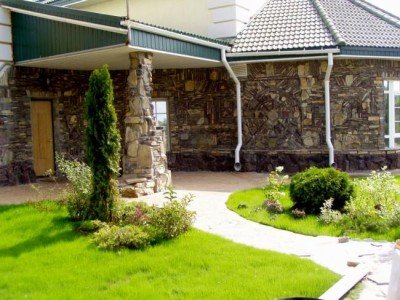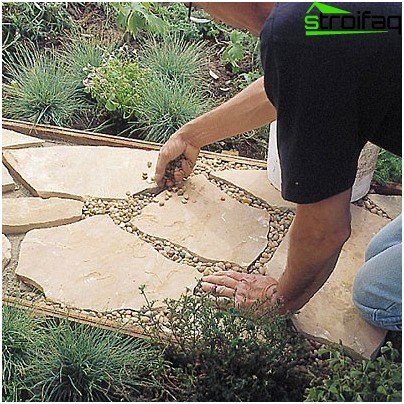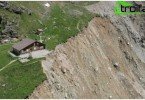Natural stone at all times has been the foundation of any construction. Marble, granite, limestone and sandstone remain the most popular building materials today. Thoughtful laying of natural stone can decorate the foundations and walls of houses, help equip ponds and paths in the plots. This is a great way to decorate borders and fences, fences. Knowing its basic laws, you can quickly and with a minimum of cost refine any building, create a simple but effective architectural mini-object, sculpture.
Content
- Work technology
- Styling nuances
- Basic principles
Due to the improvement of manufacturing technologies, artificial analogues are no less popular – laying of artificial stone simplifies the decoration process, because it, as a rule, has the correct shape, unlike wild stones. Nevertheless, an artificial stone has equally impressive aesthetic qualities, and in terms of strength and durability, it will probably be more practical than wild stones.
Be that as it may, both types of stone are used for decorative purposes. Laying a decorative stone of any origin (whether nature has tried for its creation for millions of years, or is it a product of the creation of stonecutters in some workshop with modern equipment) is a simple process. If you have even the slightest idea of how the finishing work should go, this task will be up to you..
Work technology
Before deciding to use at least artificial, at least wild stone in construction, pay attention to the fact that both of these varieties are used for the most part for facing, finishing work, but not for full-fledged construction. Artificial stones are made of porcelain stoneware, agglomerate and cement mortars – the strength of these materials is high, but still insufficient to withstand the load of the entire building, keep this in mind. Landscaping, decoration of buildings – this is where the laying of decorative stone will be in place and will not disappoint you afterwards.
The technologies for laying natural stone and its artificial analogues, if the source material has the correct geometric shape, are identical to the method of laying bricks. The process is carried out either on the basis of fastening solutions, or, so to speak, “dry”. Hence two technologies:
- The “dry” way. To improve the density and reliability of the masonry, in this case, the gaps between the pebbles are filled with earth, clay or cementing mixtures. Most often, this method is used when laying curbs, to design low fences and fences, since the strength of such a pile of stones is insufficient for high heights – the design can turn out to be very unstable. But such a connection looks very textured and effective. With irregularly shaped stones, this technology is an order of magnitude more difficult to perform, since it is very difficult to fit units that are different in thickness, density and height.
- “Wet” laying of wild stone and artificial pebbles is durable and effective for the construction of structures of any height and shape. It is especially good for building solid monolithic structures. This method does not require careful fitting of units to each other – binders fill the gaps, firmly connecting the stones together and allowing to achieve the ideal form of construction. Equally good for both artificial stones and wild rocks.
Styling nuances
When working with untreated stones that have an irregular, torn shape and fluctuating thickness, it is very important to calculate the load:
- For facing vertical surfaces (facades, warp bases, walls), stones 1-2 cm thick are used.
- For the arrangement of the site (paths, sidewalks, etc.), a thickness of stones of 2–2.5 cm will be sufficient.
- If you are covering with a stone a platform on which heavy equipment is supposed to be placed, choose stones from 4 cm thick.
For paths and paths it is better to use stones denser
For finishing vertical planes, stones are sorted by weight and size: the largest are installed in the base, in the lower rows. Also, for facing the corner sections and making the intersection of the walls, take stones more carefully. Also, make sure that the horizontal seams of the next rows are slightly offset – so that the joints between the pebbles do not coincide in all rows (work on the principle of laying the same brick). So your coating will be stronger and more durable.
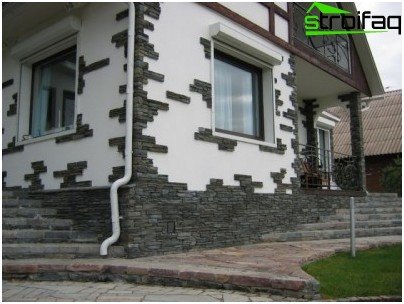
For facing vertical surfaces, choose flat stone shapes
Make sure that there is a little excess of mortar, sink the boulders into it with a hammer-cam. After tamping the stones, give the excess cement – or any other mortar that you decide to use – to spread over the vertical seams between them. If there are gaps between large units, fill them with smaller stones, or even gravel, gravel.
Tip. If, due to carelessness, a solution or a binder mixture is spilled on the front side of an already laid stone, do not rush to wipe it off with a wet sponge immediately. So you just fill the pores of the rock with a solution, and nothing can be done with this stain. Wait until the mixture dries and scrape it off with a spatula, rubbing the freed surface with a dry cloth.
Also, do not forget to stack spoon and bonded stones one by one – all according to the same principle of laying bricks – this will save you from the need to accurately adjust different sized boulders and save a lot of time.
Basic principles
In order for the surface of your cladding to maintain aesthetics and attractiveness, follow the simple principles of working with stone, and your coating will serve faithfully for many years:
1. Do not engage in improvisation – its fruits do not always correspond to your idea of how it will look in practice. Be sure to think in advance about the pattern of your masonry, laying a wild stone does not endure a fuss: consider alternating sizes, dark and light boulders, perhaps the pattern you want to achieve.
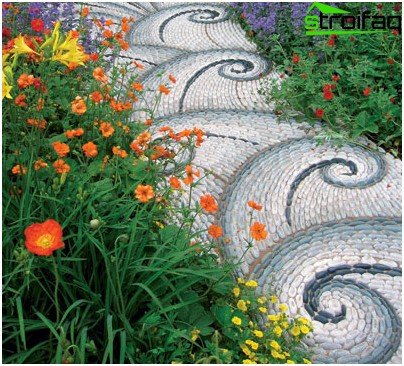
It is better to think over the future pattern in advance to avoid disappointments.
2. Usually decorative stones are laid, starting from the upper rows – this will avoid getting the mortar on the front surface of the previous, already laid rows of stones. But she, as we already know, is not very easy to clean.
3. Apply glue or cement mortar to both the base and the back of the unit, this is important – as the lining will turn out to be whole, its individual pieces will not sprinkle in a few months.
4. Be sure to level and degrease the surface that you intend to clad. It should not be dust, stains, foreign substances and objects.
5. After all the stones are laid, cover your creation with protective soil or water repellent – it will be stronger, it will last longer.
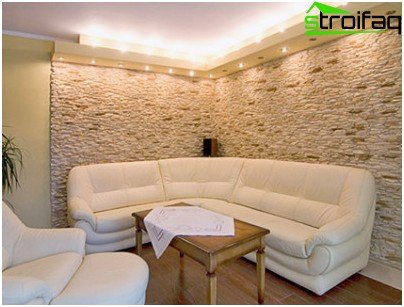
In interior decoration, natural and artificial stones are also used
As you can see, there are no special difficulties in the process of laying both wild and artificial stones. The main thing is consistency, a spark of fantasy and a little patience..


